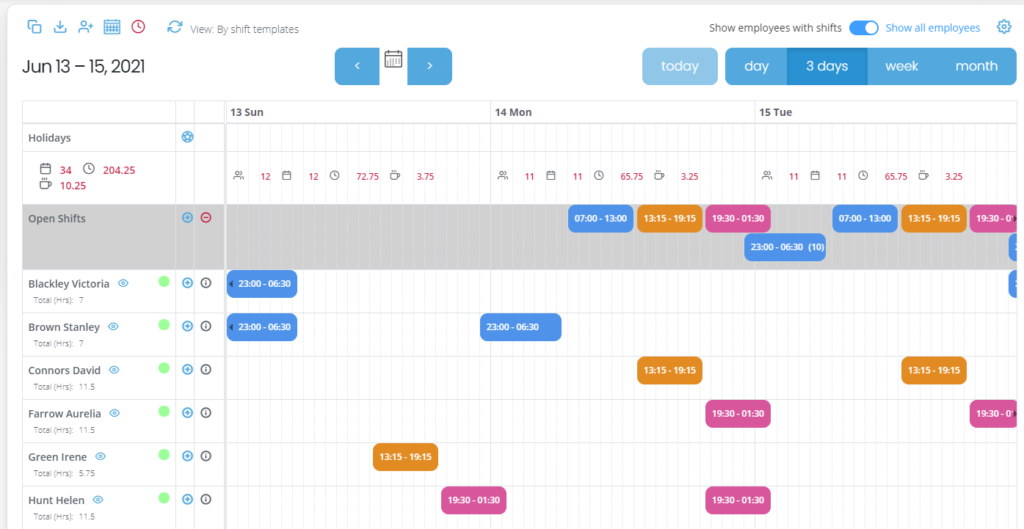In today’s fast-paced business world, organizations with employees working in shifts face the challenge of creating schedules that meet operational needs while balancing the needs and preferences of their staff. Whether you are managing a team in a healthcare facility, a retail store, or a call center, ensuring a smooth shift scheduling process is crucial. This is where a Shifting Schedule Maker can make all the difference.
In this blog, we’ll dive into what a shifting schedule maker is, why it’s important, and how it can streamline your workforce management process for better productivity and employee satisfaction.
What is a Shifting Schedule Maker?
A Shifting Schedule Maker is a tool or software solution designed to create, manage, and optimize work schedules for employees who work in shifts. These tools help managers or HR personnel assign shifts to workers based on their availability, labor laws, business needs, and personal preferences. The goal of a shifting schedule maker is to ensure efficient, fair, and conflict-free schedules while minimizing errors and reducing the manual workload involved in scheduling. From simple spreadsheet templates to AI-powered software integrated with HR systems, shifting schedule makers are designed to meet the specific needs of businesses and enhance their workforce management capabilities.
Why is a Shifting Schedule Maker Important?
Efficient shift scheduling is essential for ensuring that businesses run smoothly, employees are satisfied, and operational needs are met. One of the major challenges in managing shift workers is scheduling conflicts, such as double-booking shifts or employees requesting time off during peak hours. A shifting schedule maker helps automate the scheduling process to avoid these conflicts, ensuring that each employee is scheduled fairly. Additionally, a well-structured schedule takes into account compliance with labor laws, company policies, and employee preferences, creating a balance that benefits both the business and its workforce.
With automation in place, the need for manually updating or recalculating shifts decreases significantly, saving valuable time for managers. Moreover, the accuracy and consistency of scheduling improve, reducing the potential for errors that could disrupt operations or lead to disgruntled employees. Overall, the importance of a shifting schedule maker lies in its ability to streamline scheduling, promote fairness, and enhance operational efficiency.
Reducing Scheduling Conflicts and Errors
One of the biggest challenges in shift scheduling is handling conflicts that arise from employee availability and unforeseen circumstances like illness or emergencies. A shifting schedule maker helps reduce these conflicts by automating the process of assigning shifts and considering factors such as employee preferences and legal restrictions. By eliminating the manual effort involved in scheduling, the tool minimizes the risk of double-booking shifts, overlooking time-off requests, or accidentally scheduling employees beyond their legal working hours.
Moreover, a shifting schedule maker integrates key features such as time-off requests, shift swaps, and shift changes, making it easier to manage adjustments and updates. Employees can submit their requests through the system, and managers can review and approve them efficiently. This automated approach not only minimizes errors but also ensures that the schedule remains accurate and up to date.
Increasing Employee Satisfaction with Flexibility
Employee satisfaction is greatly influenced by their work schedules. When employees have input into their shifts and know that their preferences are being considered, they are more likely to feel valued and engaged. A shifting schedule maker typically offers features that allow employees to specify their availability, request specific days off, and even swap shifts with colleagues. This level of flexibility helps to ensure that employees are satisfied with their schedules, which can lead to increased morale and retention.
Having the ability to make schedule adjustments through an easy-to-use platform also reduces the likelihood of employees feeling frustrated or overworked. With features like self-service shift swapping, employees can manage their schedules with minimal intervention from management, providing them with greater autonomy over their work-life balance. As a result, employee satisfaction and productivity are likely to improve, which benefits the overall success of the business.
Ensuring Compliance with Labor Laws
Adhering to labor laws is critical in shift-based businesses, particularly when it comes to managing employee working hours, mandatory breaks, and overtime rules. A shifting schedule maker is designed to help businesses comply with these legal requirements by automatically tracking and flagging potential violations. For instance, if an employee exceeds the maximum allowed working hours or is scheduled for shifts that violate break regulations, the system will notify the manager and suggest corrective actions.
This level of automation ensures that businesses are consistently compliant with local labor laws, avoiding potential legal issues, fines, or employee dissatisfaction due to improper scheduling. By integrating these compliance checks into the scheduling process, businesses can focus more on their operations while minimizing legal risks.
Optimizing Staffing and Reducing Costs
Effective shift scheduling helps optimize staffing levels by ensuring that the right number of employees are working at the right times. A shifting schedule maker can analyze historical data and business trends to predict peak periods and slow hours. This allows managers to schedule just the right amount of staff, preventing overstaffing or understaffing, both of which can have a negative impact on costs and productivity.
Overstaffing can lead to wasted labor costs, while understaffing can result in poor service and employee burnout. By optimizing staffing based on demand, businesses can ensure that they meet operational needs without incurring unnecessary costs. A shifting schedule maker can provide insights and analytics to help businesses make data-driven decisions about when to schedule more staff and when to cut back.
Key Features of a Shifting Schedule Maker
When choosing a shifting schedule maker for your business, there are several essential features to look for to ensure maximum efficiency. One important feature is employee availability tracking. This allows employees to specify when they are available to work, which helps managers create schedules that take personal preferences into account while ensuring that staffing needs are met. The system can flag potential conflicts and make recommendations based on availability, reducing manual effort and errors.
Shift swapping and time-off requests are also essential features in a good shifting schedule maker. These tools allow employees to swap shifts with colleagues or request time off easily, making the scheduling process more flexible and reducing the workload for managers. Automated approval workflows ensure that managers can review and approve requests promptly, keeping the schedule running smoothly.
Another important feature is compliance monitoring. A shifting schedule maker should include tools that ensure schedules comply with labor laws, such as maximum working hours, overtime limits, and mandatory breaks. This functionality helps businesses avoid legal issues and protect both the company and employees from potential disputes.
Mobile accessibility is another crucial feature to consider. A mobile-friendly scheduling tool allows employees to view and update their schedules on the go. With real-time notifications and alerts, employees can stay informed about any changes to their shifts, improving communication and reducing confusion.
Conclusion
Managing a shift-based workforce is challenging, but a shifting schedule maker can significantly simplify the process. By automating scheduling tasks, ensuring compliance with labor laws, and offering greater flexibility for employees, these tools help businesses run more efficiently while improving employee satisfaction. Whether you’re a small business or a large organization, investing in a shifting schedule maker can save time, reduce errors, and optimize staffing levels, leading to better operational outcomes and a more engaged workforce. If you’re looking to improve workforce management and take your business to the next level, a shifting schedule maker is an essential tool to consider.







